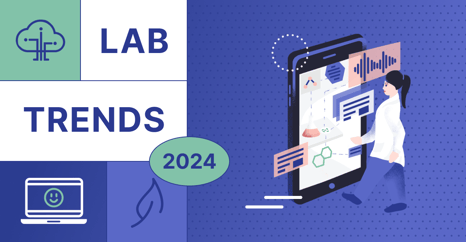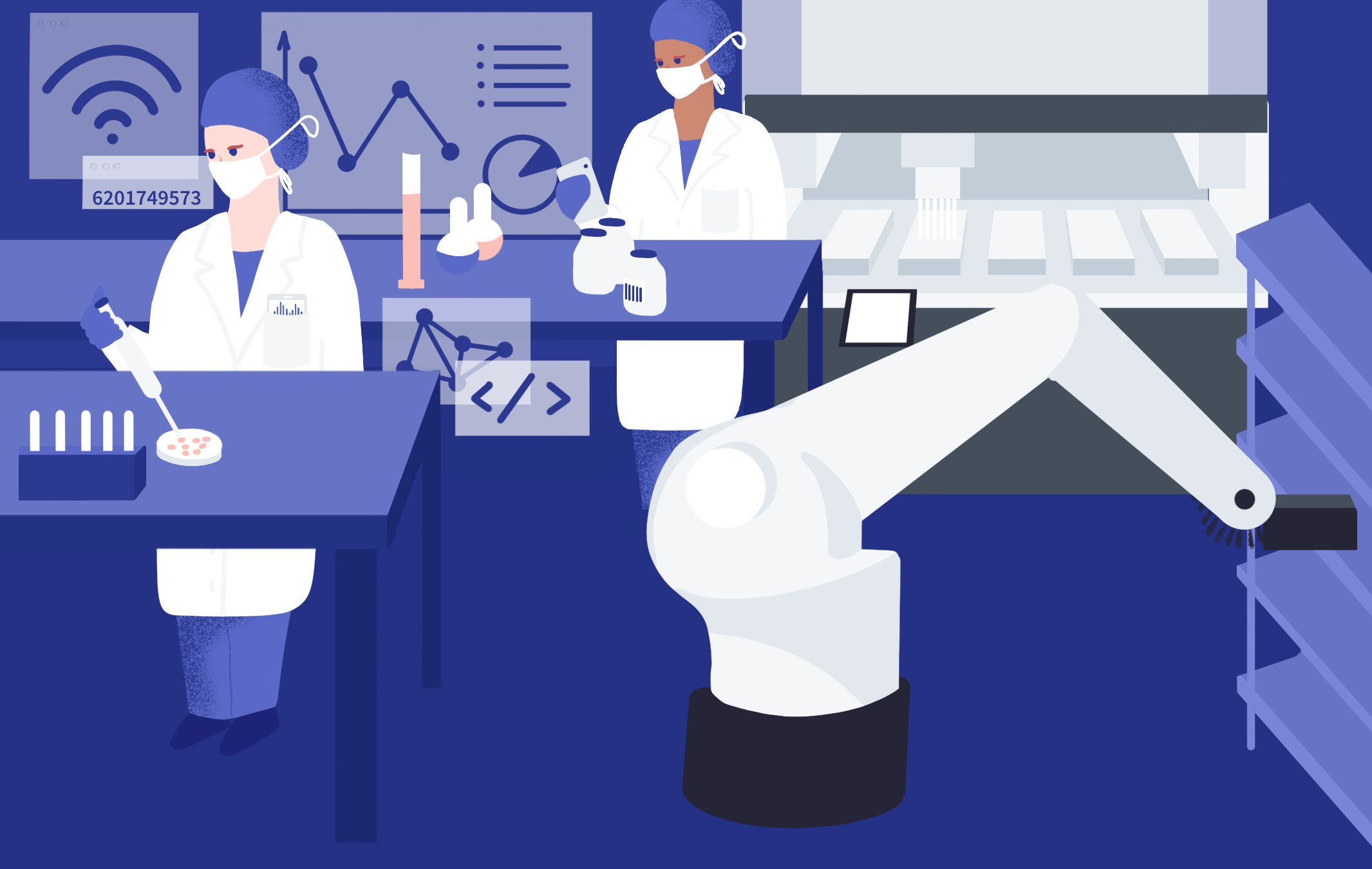
In the ever-evolving landscape of laboratory operations, 2024 is geared for a significant transformation driven by the integration of cutting-edge AI-powered digital technologies. The convergence of Large Language Models (LLMs) advances with cloud-based solutions and low-code/no-code personalized interfaces to increase lab automation is set to revolutionize how laboratories operate, analyze data, and adapt to the increasing demand for efficiency and innovation.
The pervasive influence of AI is no longer confined to research labs and specialized applications. The breakthroughs in Large Language Models (LLMs) have democratized AI, making it accessible across various domains. In 2024, laboratories are expected to explore the extensive applications of AI in streamlining processes, optimizing workflows, and enhancing decision-making.
The recent advancements in LLMs, such as GPT-4, have unlocked new possibilities for natural language processing and understanding. Laboratories can leverage these capabilities to streamline documentation, data interpretation, and communication. For instance, AI-driven systems can assist in summarizing research findings, automatically generating reports, and facilitating seamless collaboration among researchers (read our blog on LLMs for scientists).
AI's role in data analysis is set to expand further. Beyond automation, AI algorithms can derive meaningful insights from complex datasets, aiding researchers in making informed decisions. Integrating AI into laboratory workflows can expedite data processing, enhance accuracy, and identify patterns that might go unnoticed through traditional analytical methods.
Evaluating AI Everywhere
As AI becomes a cornerstone of laboratory processes, a thorough evaluation of existing workflows is necessary. Identifying areas where AI can provide support, whether in experimental design, data analysis, or result interpretation, will be crucial for harnessing the full potential of this technology. Many existing lab informatics products as well as new tools are leveraging AI (learn more about how LabTwin is leveraging AI) to accelerate lab workflows and their potential impact and value-gain would deserve to be thoroughly evaluated (discover how our clients generated more data in our Fact Sheet)
%20(1)%20(1).jpg?width=1200&height=600&name=How%20Cloud%20Technology%20Can%20Transform%20Pharma%20R%26D-Lab%20of%20the%20Future%20(2)%20(1)%20(1).jpg)
The seamless integration of AI into laboratory workflows often demands significant computational power. Cloud-based solutions emerge as a fundamental enabler, offering scalable infrastructure and facilitating the deployment of sophisticated AI models.
Computing Power and Flexibility
Cloud computing provides laboratories with the computational muscle needed to process large datasets, run complex simulations, and execute resource-intensive AI algorithms. The flexibility of cloud-based solutions allows laboratories to scale their computing resources dynamically, accommodating varying workloads and ensuring optimal performance during peak demand periods.
Collaborative Research
The collaborative nature of cloud platforms enhances information sharing and collaboration among researchers, even in geographically dispersed teams. Cloud-based solutions enable real-time access to shared datasets, collaborative analysis, and seamless communication, fostering a more connected and efficient research environment.
Security Considerations
As laboratories migrate to cloud solutions, robust security measures are imperative. Ensuring the confidentiality and integrity of sensitive research data becomes a top priority, necessitating the implementation of encryption protocols, access controls, and regular security audits. However, by being constantly updated with the latest security measures while enabling seamless data transfer, cloud solutions are safer than on premises.
Interoperability
Being on the cloud is key for lab connectivity and interoperability.
Electronic Lab Notebooks (ELNs), such as Revvity Signals, are available on the cloud to provide powerful analytics and a safe collaborative environment, and can, therefore, seamlessly integrate with other lab informatics solutions such as LabTwin or Scitara (watch our latest webinar with our partner Revvity)
The increasing reliance on data-driven decision-making necessitates user-friendly interfaces that empower researchers, regardless of their programming skills, to extract valuable insights from complex datasets. Low-code/no-code platforms emerge as a solution to democratize data analysis.
Customizable Interfaces
Low-code/no-code platforms provide customizable interfaces that empower users to design and implement data analysis workflows without the need for extensive coding. Researchers can tailor interfaces to their specific needs, accelerating lab operations and data analysis processes and promoting a more intuitive user experience.
Accelerating Decision-Making
By democratizing access to data analysis tools, laboratories can expedite decision-making processes. Researchers gain the ability to explore and interpret data independently, reducing the dependency on specialized data analysts and promoting a culture of continuous learning and improvement.
Integration with AI
The synergy between low-code/no-code interfaces and AI technologies is a promising avenue for 2024. Integrating pre-built AI modules into these platforms can further simplify complex analyses or accelerate workflows, allowing researchers to leverage advanced algorithms without diving into the intricacies of AI programming.

The demand for laboratory services is growing exponentially, creating staffing shortages against financial constraints. Automation has emerged as a strategic solution to streamline routine tasks, enhance efficiency, and ensure the timely completion of experiments. It will need to be actively leveraged to keep up with the fast pace of innovation.
Connected Network of Lab Informatics Tools and Devices
Well-connected and accessible lab informatics systems play a pivotal role in automation. Automated data collection from connected devices, data integration, and sharing through interconnected informatics platforms reduce manual interventions, minimize errors, and accelerate the overall research cycle.
Attracting and Retaining Human Expertise
While automation addresses efficiency challenges, laboratories must strike a balance between automated processes and the expertise of human researchers. Automation should complement human skills, allowing scientists to focus on high-level tasks such as experimental design, result interpretation, and innovation. Keeping talents will also mean fostering a deeply caring and positive work culture while providing modern working conditions, including recent lab technologies (read our blog on empowering talents instead of hiring).
The laboratory digitalization trends for 2024 reflect a paradigm shift in how laboratories operate, collaborate, and innovate. The integration of AI, cloud-based solutions, low-code/no-code interfaces, and automation is reshaping the research landscape, offering unprecedented opportunities for efficiency, scalability, and democratization of scientific processes.
As laboratories embrace these trends, careful consideration must be given to ethical considerations, data security, and the ongoing development of a conducive work culture that attracts and retains top talents. The synergy of human expertise with cutting-edge digital technologies promises a future where laboratories can not only meet the demands of a dynamic research environment but also drive transformative advancements across various scientific disciplines.
Reach out to our digitalization experts to discuss your own use cases and digitalization goals, or simply book a demo in our calendar.

%20(1)-1.png?width=164&height=164&name=Ellipse%2052%20(Stroke)%20(1)-1.png)